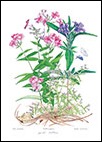
June 22
Smooth Phlox (Phlox glaberrima)
Ruellia (Ruellia ceroliniensis)
Summer Bluets (Houstonia purpurea)
All three of these plants have bluish shades of color and get along quite well together where I find them in my woodland border. An orange or red flower just wouldn’t have much in common with this group. Mother Nature does a great job of landscape design.
These plants are like treasured friends of mine. They don’t ask much of me and I can always count on them being there. Some are quiet and subtle, some are strong and dependable, and some, like the Smooth Phlox, always seem to attract attention. Individual pink flowers of Smooth Phlox come and go but there is a long duration of colorful blooms. Bloom time can be extended further by removing faded flowers. Or, just leave them alone so they can reseed. It’ll be fine. At any rate, Smooth Phlox is a perennial and will come back each year. They don’t seem to ever have pests or diseases.
Native plant people are lucky to be alive. We drive with one eye on the road and one eye on the side of the road—to see what’s blooming. That is how I first saw Ruellia. I made a note to go back and collect seed later in the year. But right away I was happy see her show up in my garden. Now, like a loyal friend, she is there when I need her each year. The blue violet flowers don’t last long but the plant keeps offering new ones while the faded blooms quietly slip away. Even after blooming, this perennial contributes to the garden with her lovely green foliage. I’ve learned to recognize the tufted appearance of the leaves, spaced at tiers up and down the stem, so I can protect her.
Sweet little Summer Bluets don’t get much taller than ten inches in my garden. They quietly fill in where needed around the stems of taller plants, the way we use baby’s breath in a bouquet. Several stems rise from a root crown. Its little cousin, Houstonia caerulea, which we simply call Bluets, blooms much earlier and is seen in one of my other paintings (March 26, Trout-lily).
Remember, these are native plants that were growing in this spot before our house was even built. I didn’t plant them. More importantly, I didn’t dig them up, “amend” the soil and plant some foreign species in their place. Nothing could be prettier.
(Click on the picture for a larger image)
(Click here for the next painting)


